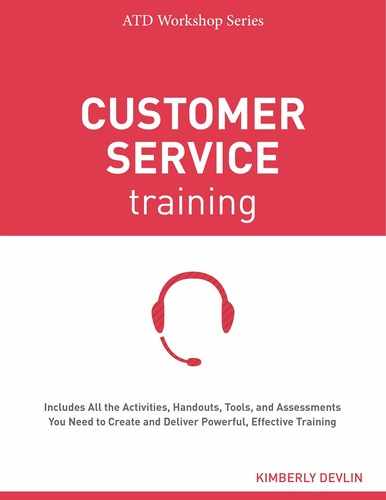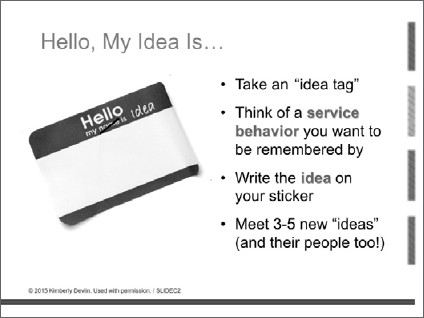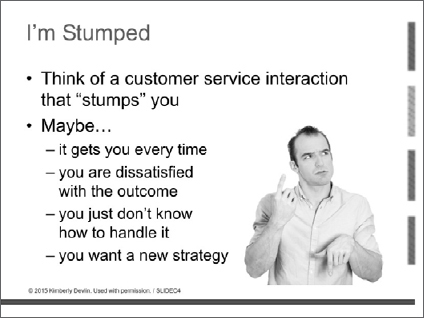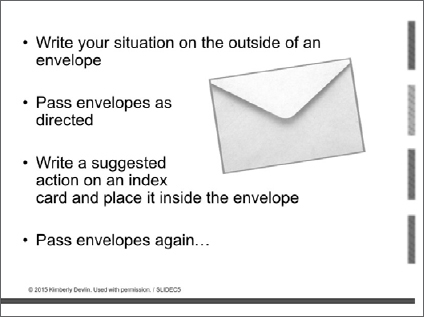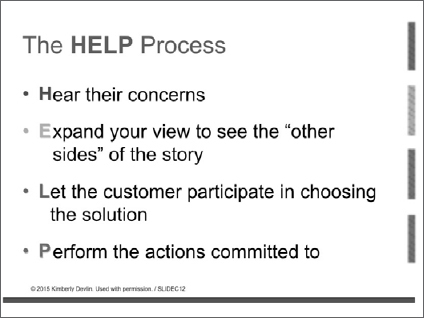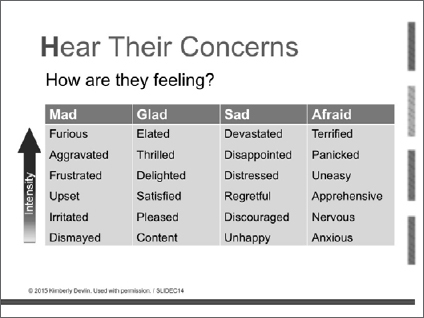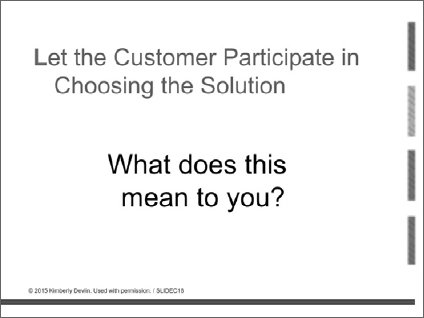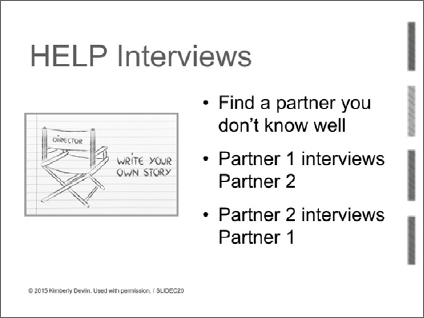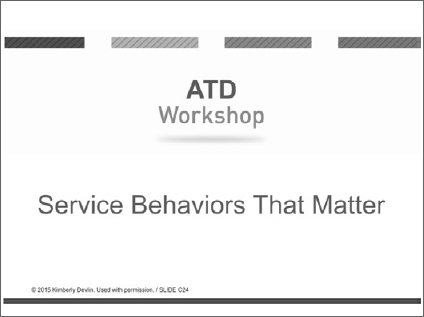Chapter 1
Half-Day Customer Service Workshop: Service Behaviors That Matter
What’s in This Chapter
• Objectives of the half-day Customer Service Workshop
• Summary chart for the flow of content and activities
• Half-day program agenda
![]()
Do your workshop participants have limited experience as effective service providers? Are they routinely dealing with angry customers? Will the concept of internal customers be new to them? Is the organization’s leadership asking for improved service behaviors? If you answered yes to any of these questions, then this workshop is a logical match to meet the training need. With a focus on resolving difficult situations, identifying language that deescalates conflict, reacting effectively when the customer is behaving poorly, and following a four-step HELP process, this comprehensive half-day session will provide engaging and powerful tools to help service providers improve the customer experience at your organization. Get ready to have some fun with this workshop.
Half-Day Workshop Objectives: Service Behaviors That Matter
Here are the learning objectives for the half-day workshop:
• Develop a personalized set of phrases and actions to increase customer satisfaction.
• Diffuse escalating customer situations through word choice and actions.
• Follow the four-step HELP process for customer interactions.
• Distinguish service behaviors from service strategies and service systems.
Half-Day Workshop Overview
| TOPICS | TIMING |
| Welcome/Learning Activity 1: Intriguing Question or Story | 5 minutes |
| Icebreaker/Learning Activity 2: Hello, My Idea Is … | 15 minutes |
| Program Objectives and Social Agreements/Learning Activity 3: Prioritize Learning | 5 minutes |
| Learning Objective 1/Learning Activity 4: I’m Stumped | 30 minutes |
| Learning Objective 2/Learning Activity 5: Keep a Cool Head | 20 minutes |
| BREAK | 15 minutes |
| Learning Objective 2/Learning Activity 6: Quit Taking It Personally (Q-Tip) | 20 minutes |
| Learning Objective 3/Learning Activity 7: The HELP Process for Customer Interactions | 15 minutes |
| Learning Objective 3/Learning Activity 8: HELP the Customer | 40 minutes |
| Learning Objective 4/Learning Activity 9: Interconnected Service Facets | 10 minutes |
| Course Closure | 5 minutes |
| TOTAL | 180 minutes (3 hours) |
A Word About Presentation Slides and Handouts
The presentation slides for this workshop have been animated to enhance their effectiveness. They can be used effectively in the pdf format (which are static), but if you choose to use the fully customizable versions and display the slides in slide show mode, many will have motion and builds. These animations are not merely movement; they are structured to enhance the visuals’ effectiveness, provide greater facilitative control of group discussions, manage cognitive load by chunking content in keeping with activity instructions, and in some instances, even provide feedback to the participants. Some animations are controlled by advancing the slides, and others are automated for you. This is intentional to guide certain activities and to offer you facilitative flexibility in others. Make time to familiarize yourself with the animations and plan how you will leverage them. You can run the workshop effectively using the pdf versions; however, if you are accessing the presentation slides in their native format through an optional license, be sure to display them in slide show mode to derive their full benefit!
Please note that some slides in this workshop may also appear in the one-day or two-day workshops. Their animations here may be a bit different, in support of this workshop’s structure. Please be sure to familiarize yourself with these animations, even if you previously reviewed a different workshop’s visuals.
Each workshop has been designed as a continuous event. If facilitated that way, it may be logical for you to assemble all of the associated handouts into one bound workbook to distribute to participants when they arrive. In this case, where the learning activities direct you to distribute a handout, you may want to make note of and refer to the appropriate workbook pages during the workshop.
Half-Day Workshop Agenda
Even in a half-day workshop, time can get away from you. Interesting questions, lengthy group discussions, and tangential concerns can all potentially enhance or derail a workshop agenda. You are encouraged to keep this table readily available for reference during the workshop and to support you in remaining on schedule while being responsive to participants’ unique needs. You will also want a reference set of the handouts (Chapter 13) and the details of the workshop design included in the learning activity pages (Chapter 11)—be sure to have those pages available during your facilitation.
| Half Day: (9:00 a.m. to 12:00 p.m.) | ||
| TIMING | SLIDES | ACTIVITIES/NOTES/CONSIDERATIONS |
|
9:00 a.m. (5 min) |
Slide 1
|
Welcome/Learning Activity 1: Intriguing Question or Story Plan an opener that sets the tone for the learning event—ideas are included in the learning activity; choose one or create your own. Start strong, grab your learners’ interest, and let them see the value of this learning event to their workplace performance. Use this learning activity to establish the learners’ expectations, not as housekeeping, introductions, or generalized “welcoming” comments (you will do that later in the workshop). |
|
9:05 a.m. (15 min) |
Slide 2
|
Icebreaker/Learning Activity 2: Hello, My Idea Is … • Handout 1: Hello, My Idea Is … This large group activity will help participants meet other participants and share their strategies for effectively delivering customer service. To help them get started, share an example of an effective customer service idea from your own best practices. Use the instructions in the learning activity to guide the exercise. Following the debrief, integrate a complete self-introduction, focusing on your experience and expertise with customer service. |
|
9:20 a.m. (5 min) |
Slide 3
|
Program Objectives and Social Agreements/Learning Activity 3: Prioritize Learning • Handout 2: Learning Objectives This individual activity introduces the workshop’s learning objectives. You are encouraged to share a prepared chart of social agreements (ground rules) appropriate to your group after the activity. |
|
9:25 a.m. (30 min) |
Slide 4
|
Learning Objective 1/Learning Activity 4: I’m Stumped • Handout 3: I’m Stumped Idea Starters This team activity supports the first learning objective—develop a personalized set of phrases and actions to use to increase customer satisfaction. Following a brief discussion of barriers to delivering quality service to every customer, ask participants to write a service challenge that “stumps” them on an envelope. Encourage them to choose a challenge for which they would like fresh ideas from the group. Use the instructions in the learning activity and on these two slides to conduct the activity. Lead a large group discussion to debrief the exercise (questions are included at the end of the learning activity). (Slide 1 of 2) |
|
|
Slide 5
|
(Slide 2 of 2) |
|
9:55 a.m. (20 min) |
Slide 6
|
Learning Objective 2/Learning Activity 5: Keep a Cool Head • Handout 4: Keep a Cool Head This large group activity supports the second learning objective—diffuse escalating customer situations through word choice and actions. In this activity, participants identify terms and phrases that increase conflict, strategize on how to respond to them to reduce their conflict-causing effects, and list alternative phrases so that they do not create the conflict. Use the instructions in the learning activity and these three slides to conduct the exercise. (Slide 1 of 3) |
|
|
Slide 7
|
Use this slide to focus participants’ attention during the group discussion. (Slide 2 of 3) |
|
|
Slide 8
|
Use this slide to encourage participants to compare their ideas to some prepared answers. Note: The animation in the customizable slides will provide feedback on participants’ interpretation versus the actual alignment with the escalating and deescalating labels. If you are using the free, pdf-version of the presentation slides, the slide will automatically display the aligned positioning shown at left. (Slide 3 of 3) |
|
10:15 a.m. (15 min) |
Slide 9
|
BREAK |
|
10:30 a.m. (20 min) |
Slide 10
|
Learning Objective 2/Learning Activity 6: Quit Taking It Personally (Q-Tip) • Handout 5: Quit Taking It Personally (Q-Tip) This pop-up activity also supports the second learning objective. Use this slide to review (briefly) the types of customer behaviors that can trigger an emotional reaction. (Slide 1 of 2) |
|
|
Slide 11
|
During the pop-up, participants generate neutral and customer-focused responses to sample language customers may say. Colleagues will vote on the effectiveness of the responses shared using colored cards. Use the instructions in the learning activity and this slide to introduce and facilitate the exercise. (Slide 2 of 2) |
|
10:50 a.m. (15 min) |
Slide 12
|
Learning Objective 3/Learning Activity 7: The HELP Process for Customer Interactions • Handout 6: The HELP Process for Customer Interactions This facilitated discussion supports the third learning objective—follow the four-step HELP process for customer interactions. Refer to the content in the learning activity and these slides to lead a discussion that relies heavily on questioning techniques and intersperses a minimal amount of “lecturette” to explain the HELP process. Plan to supplement the comments shared by the participants with the content provided for you. (Slide 1 of 8) |
|
|
Slide 13
|
(Slide 2 of 8) |
|
|
Slide 14
|
(Slide 3 of 8) |
|
|
Slide 15
|
(Slide 4 of 8) |
|
|
Slide 16
|
(Slide 5 of 8) |
|
|
Slide 17
|
(Slide 6 of 8) |
|
|
Slide 18
|
(Slide 7 of 8) |
|
|
Slide 19
|
(Slide 8 of 8) |
|
11:05 a.m. (40 min) |
Slide 20
|
Learning Objective 3/Learning Activity 8: HELP the Customer • Handout 7: HELP the Customer—Interview Tool • Handout 8: HELP the Customer—Planning Worksheet • Handout 9: HELP the Customer—Observer Worksheet This two-part activity also supports the third learning objective. Part one involves partner interviews to elicit real-world challenges. Part two provides an opportunity to role play the challenges surfaced during the interviews. Use the instructions in the learning activity and this slide to pair up participants for interviews. (Slide 1 of 3) |
|
|
Slide 21
|
Use the instructions in the learning activity and this slide to lead participants to prepare for quad role plays. (Slide 2 of 3) |
|
|
Slide 22
|
Display this slide during the quad role plays as a support tool participants may want to reference. (Slide 3 of 3) |
|
11:45 a.m. (10 min) |
Slide 23
|
Learning Objective 4/Learning Activity 9: Interconnected Service Facets • Handout 10: Interconnected Service Facets This facilitated discussion supports the fourth learning objective—distinguish service behaviors from service strategies and service systems. Use the content in the learning activity and this slide to introduce the idea that there are three service facets and this workshop focused on just one (service behaviors). |
|
11:55 a.m. (5 min) End at noon. |
Slide 24
|
Course Closure • Handout 11: Course Evaluation—Service Behaviors That Matter Share next steps (if program is part of a larger organizational initiative). Collect completed course evaluations. Distribute certificates (if provided). |
What to Do Next
• Review Chapter 10 and create your workshop support plan:
![]() Select the most effective pre- and post-workshop communication strategies.
Select the most effective pre- and post-workshop communication strategies.
![]() Involve participants’ managers early on.
Involve participants’ managers early on.
![]() Choose the follow-up coaching strategies that most efficiently align with your workshop rollout.
Choose the follow-up coaching strategies that most efficiently align with your workshop rollout.
• Manage workshop logistics:
![]() Identify participants.
Identify participants.
![]() Schedule the workshop date, reserve an appropriate location, and invite participants.
Schedule the workshop date, reserve an appropriate location, and invite participants.
![]() Inform participants about any pre-work, if you are adding it to the workshop.
Inform participants about any pre-work, if you are adding it to the workshop.
![]() Prepare copies of the participant handouts (refer to Chapter 14 for information about how to access and use the supplemental materials provided for this workshop).
Prepare copies of the participant handouts (refer to Chapter 14 for information about how to access and use the supplemental materials provided for this workshop).
![]() Coordinate catering, if being provided.
Coordinate catering, if being provided.
• Prepare yourself for the workshop:
![]() Review the workshop objectives, learning activities, and handouts to plan the content you will use.
Review the workshop objectives, learning activities, and handouts to plan the content you will use.
![]() Confirm that you have addressed scheduling and personal concerns so that you can be fully present to facilitate the class.
Confirm that you have addressed scheduling and personal concerns so that you can be fully present to facilitate the class.
![]() Set an out-of-office email auto response for the day of the workshop.
Set an out-of-office email auto response for the day of the workshop.
• Pack your bag:
![]() Gather the workshop essentials: participant materials, slide show file, facilitator notes (learning activity pages in Chapter 11), and any activity materials noted in the learning activities (such as customized manipulatives, index cards, envelopes, or others).
Gather the workshop essentials: participant materials, slide show file, facilitator notes (learning activity pages in Chapter 11), and any activity materials noted in the learning activities (such as customized manipulatives, index cards, envelopes, or others).
![]() Coordinate or bring audio-visual equipment: laptop, projector, speakers, and remote control for presentation slides.
Coordinate or bring audio-visual equipment: laptop, projector, speakers, and remote control for presentation slides.
![]() Pack training room basics: markers, tape, easels, flip charts, and tactile items, such as Koosh balls, Play-Doh, or others, to place on the tables for tactile learners.
Pack training room basics: markers, tape, easels, flip charts, and tactile items, such as Koosh balls, Play-Doh, or others, to place on the tables for tactile learners.
![]() See Chapter 8 for other ideas to enhance the learning environment of your workshop.
See Chapter 8 for other ideas to enhance the learning environment of your workshop.
